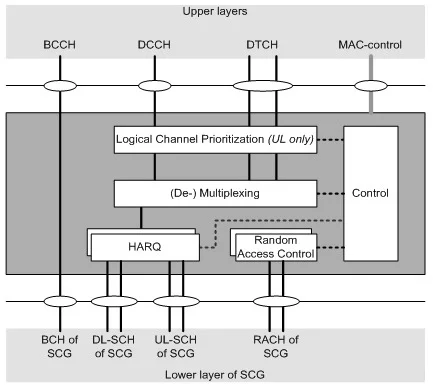Featured post
- Get link
- X
- Other Apps
5G NR MAC Layer-Architecture, Channel Mapping, Procedures
5G NR MAC Layer-Architecture, Channel Mapping, Procedures
5G NR (New Radio) is the latest cellular wireless technology developed to deliver ten times faster data rate compare to its previous LTE technology. It follows 3GPP specifications release 15 and above.
Following are the features of 5G NR technology.
• It works on two frequency bands viz. sub-6 GHz and millimeter wave (above 20 GHz).
• It supports massive MIMO with 64 to 256 antennas.
5G NR MAC Layer Architecture | 5G NR MAC Layer Functions
Physical layer provides following services to the MAC sublayer.
• Data Transfer
• HARQ feedback signaling
• Scheduling Request signaling
• CQI (Channel Quality Indication) measurements
The MAC sublayer provides two main services to upper layers viz. data transfer and radio resource allocation. The other functions of 5G NR MAC are as follows.
• Mapping between logical and transport channels (Both Downlink and Uplink).
• Multiplexing of MAC SDUs onto TBs (Transport Blocks) (In Uplink), SDUs belong to logical channels and transport blocks belong to transport channels.
• Demultiplexing of MAC SDUs from TBs (In Downlink)
• Scheduling information reporting (In Uplink)
• Error correction through HARQ (In Downlink and Uplink)
• Logical Channel Prioritisation (In Uplink)
5G NR MAC Channel Mapping
The figure-3 depicts MAC logical channels and PHY layer transport channels used in 5G NR technology. They have specific functions in the downlink or uplink. PDSCH, PBCH and PDCCH are used in the downlink where as PUSCH, PUCCH and RACH are used in the uplink. The reference signals in the downlink are DMRS, PT-RS, CSI-RS, PSS and SSS. The reference signals in the uplink are DMRS, PTRS and SRS.
5G NR MAC Procedures
Following table mentions different 5G NR MAC procedures. These procedures have their respective functionality in the 5G NR MAC layer.
| 5G NR MAC Procedures | Description |
|---|---|
| Random Access Procedure | Get the initial uplink grant for UE and helps in performing synchronization with the gNB (i.e. network). It covers Random Access procedure initialization, Random Access Resource selection, Random Access Preamble transmission, Random Access Response reception, Contention Resolution and Completion of the Random Access procedure. |
| DL-SCH data transfer | It does everything needed to perform downlink data transfer. |
| UL-SCH data transfer | It does everything needed to perform uplink data transfer. |
| Scheduling request (SR) | It is used by UE to transmit request to gNB (i.e. network) to obtain UL grant. |
| PCH reception | It helps in monitoring paging message in special time period. |
| BCH reception | It carry basic informations regarding the 5G NR cell (e.g. MIB, SFN etc.). |
| DRX (Discontinuous Reception) | It helps in monitoring PDCCH as per special pattern in discontinuous manner. Due to this discontinuous monitoring, energy consumption can be achieved. |
| Other procedures | The other 5G NR MAC procedures include transmission and reception without dynamic scheduling, activation/deactivation of SCells, activation/deactivation of PDCP duplication, BWP (Bandwidth Part) operation, handling of measurement gaps, handling of MAC CEs, beam failure detection and recovery operation etc. |
5G NR MAC Header And Subheaders
A MAC PDU consists of one or more MAC sub-PDUs. Each MAC sub-PDU consists of one of the following fields:
• A MAC subheader only (including padding)
• A MAC subheader and a MAC SDU
• A MAC subheader and a MAC CE (Control Element)
• A MAC subheader and padding
The MAC SDUs are of variable sizes. Each MAC subheader corresponds to either a MAC SDU, a MAC CE, or padding
The figure-5 depicts 5G NR MAC PDU examples for downlink (DL) and uplink (UL). Following figure-6 depicts MAC subheader types. Let us understand header and subheader fields and their respective meanings in the 5G system.
• LCID field: LCID stands for Logical Channel ID. It identifies logical channel instance of corresponding MAC SDU or type of corresponding MAC CE or padding. The values of LCID for DL-SCH and UL-SCH are mentioned in the tables below. There is only one LCID field exists for one MAC subheader. LCID field has 6 bits in size.
• L-Field: "L" indicates length field of corresponding MAC SDU or variable sized MAC CE in units of bytes. One "L-field" exists for one MAC subheader. More number of "L-fields" exist for subheaders corresponding to fixed-sized MAC CEs and padding. The "L-field" size is indicated by F-field;
• F-field: It refers to length field size. It is one bit in size. There is one F field per MAC subheader except for subheaders corresponding to fixed-sized MAC CEs and padding. The value 0 in F-field refers to 8 bits of Length field. The value 1 in F-field refers to 16 bits of Length field.
• R: Reserved bit, set to zero.
LCID Values For DL-SCH And UL-SCH
References
• 3GPP TS 38.321 V15.2.0 (2018-06), Medium Access Control (MAC) protocol specification (Release 15)
• 3GPP TS 38.300 V15.2.0 (2018-06), NR; NR and NG-RAN Overall Description; Stage 2 (Release 15)
- Get link
- X
- Other Apps
Popular Posts
5G NR TBS Calculation | 5G NR Transport Block Size Calculation
- Get link
- X
- Other Apps










Comments
Post a Comment